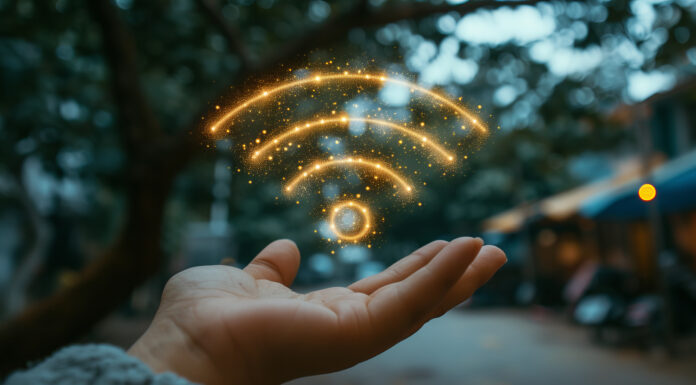At SCTE’s recent TechExpo25 in Washington, D.C., a senior White House official reminded attendees that the Trump Administration’s 2020 decision to open the full 6 GHz band to Wi-Fi should be seen as part of a US imperative for global technology leadership, and noted that it has sparked broad-based innovation to the benefit of consumers. At the same conference, Broadcom and broadband provider Charter jointly demonstrated that the innovation cycle continues with new connectivity gains in Wi-Fi that would only be possible because of the Trump Administration’s decision to open the full band for Wi-Fi, but still requires a small additional sliver of spectrum to be allocated for unlicensed use.
Observing the rapid success of Wi-Fi in the 6 GHz band, National Economic Council Deputy Director and Deputy Assistant to the President Robin Colwell said America’s unlicensed spectrum strategy is delivering. “The industry came through in a very real way,” she said. “It worked…There are active live proceedings in other countries right now, and we would like to see them follow our lead. We fought tooth and nail to get that spectrum…And it was so that we could become the worldwide leader in Wi-Fi…It worked. We were right.”
At an SCTE spectrum panel discussion, Chris Szymanski highlighted that US leadership in Wi-Fi is being felt around the world. The U.S. and countries that have adopted Wi-Fi in the full 6 GHz band are now in the lead on infrastructure capability for broadband services, with 6 GHz delivering significant value for consumers. He noted that many more countries have only partially responded, allocating just the lower portion of 6 GHz to Wi-Fi, while postponing decisions on what to do with the pper 6 GHz. Even so, he said, the world is watching the U.S.
Regulatory certainty created by the FCC’s decision to open 6 GHz, as further evidenced by Colwell’s remarks at SCTE, has unleashed an unprecedented wave of innovation in devices and technologies. Szymanski noted that the roll out of 6 GHz Wi-Fi is proceeding at a faster pace than the rollout of 2.4 GHz Wi-Fi or 5 GHz Wi-Fi when those bands were first made available, and the industry continues to deliver new innovations. Notably, almost all broadband service providers in the U.S. and Canada, regardless of broadband technology, are deploying 6 GHz access points as part of their broadband offerings.
Broadcom and Spectrum demo what’s possible with more unlicensed spectrum for next-gen Wi-Fi
At SCTE’s event, Broadcom and Charter-owned communications service provider Spectrum successfully took next-generation Wi-Fi to new heights with a peak throughput of approximately 9 Gbps to a single device in a configuration typical for smartphones, XR devices, gaming rigs or personal computers. This throughput was achieved by combining two 320 MHz channels, one of which used 125 megahertz of spectrum in the 7.125-7.25 GHz range. Broadcom and Charter are among the firms lobbying the federal government to open up additional frequencies in the lower 7 GHz band for unlicensed use.
According to the partners, making this spectrum available could enable speeds around 20 Gbps for Wi-Fi mesh networks. “This milestone highlights the power of combining Wi-Fi 7 technology with forward-looking spectrum policy,” Spectrum EVP for Technology Strategy and Innovation Justin Colwell said in a statement.
He continued: “Proactive spectrum decisions need to be made to both maintain America’s technological leadership and allow providers and manufacturers to keep pace with evolving and intensifying consumer demands. Together with Broadcom, we are showing what is possible when we combine the unparalleled success of 6 GHz Wi-Fi with adjacent 7 GHz unlicensed spectrum.”
As Wi-Fi 7 gives way to ultra-high reliability Wi-Fi 8 in the 2028 timeframe, more spectrum will mean more capabilities. Given the success of the US efforts around 6 GHz Wi-Fi — as well as the administration’s commitment to global leadership — expanding unlicensed access into the lower 7 GHz band aligns well with the goals the administration had when releasing 6 GHz spectrum.
At a policy level, Presidential advisor Colwell said the White House is focused on maintaining US leadership across communications technologies, including Wi-Fi. She shared a May 20th post to Truth Social from President Trump: “We must maintain our status as the worldwide leader in Wi-Fi, 5G and 6G, connecting every American to the world’s best networks, while also keeping everyone safe,” it read.
Colwell commented: “We have had conversations with [Trump] about this. We’re having conversations across the administration. The big highlight is that this is coming from the top.”
The key takeaway here is that there is no point in “trying to fix what’s not broken,” said Presidential advisor Colwell.
For additional reading on 6 GHz Wi-Fi, read the following articles:

